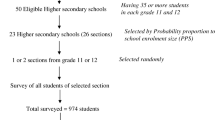Abstract
Background
The first Youth Risk Behaviour Survey in South Africa was carried out to establish the prevalence of key health risk behaviours among high school students. Though physical inactivity is a commonly reported contributory factor to chronic diseases of lifestyle in South Africa, there is no reliable national database on the participation of children and adolescents in physical activity.
Methods
This cross-sectional national prevalence study among students attending government schools in the nine provinces in South Africa utilized a two-stage cluster sample design. Statistical analysis allowed for clustered sampling, and data collected through self-administered questionnaire were weighted to reflect the underlying student population.
Results
Data of 10,699 participants were analyzed. More than one third (37.5%) of the students engaged in insufficient physical activity. By population group, a significantly lower proportion of white students (29.4%) than black (37.5%) and coloured students (45.6%) engaged in insufficient physical activity. Among those who abstained from participation, 25.9% were unwilling to participate, with significantly fewer white (26.8%) and black (25.1%) students feeling unsafe in their surroundings compared with coloured students (35.3%). Significantly fewer white students (5.6%) had no access to facilities compared to black students (17.0%). White students and students in higher grades reported lower rates of physical education classes at school.
Interpretation
Though the promotion of physical activity and healthy lifestyle is a national priority in South Africa, the survey indicates the need to pay attention to an appreciable proportion of high school students who do not participate sufficiently in physical activity.
Résumé
Contexte
L’Afrique du Sud a fait l’objet d’une première enquête visant à déterminer la prévalence des principaux comportements présentant un risque pour la santé chez les élèves du secondaire. La sédentarité est l’un des facteurs contributifs les plus communément liés aux maladies chroniques dues au mode de vie en Afrique du Sud, mais il n’existait pas jusqu’ici de base de données fiable, à l’échelle nationale, sur l’activité physique chez les enfants et les adolescents.
Méthode
L’enquête transversale nationale, qui visait les élèves fréquentant l’école publique dans les neuf provinces d’Afrique du Sud, faisait appel à un échantillonnage à deux degrés. Une analyse statistique a permis un échantillonnage en grappes, et les données recueillies au moyen de questionnaires à remplir soi-même ont été pondérées en fonction de la population étudiante sous-jacente.
Résultats
Les données de 10 699 participants ont été analysées. Plus du tiers des élèves (37,5 %) étaient insuffisamment actifs. Selon une analyse fondée sur le segment démographique, une proportion significativement plus faible d’élèves blancs (29,4 %) que d’élèves noirs (37,5 %) et d’élèves de couleur (45,6 %) étaient insuffisamment actifs. Chez ces élèves sédentaires, 25,9 % l’étaient par choix; les élèves qui ne se sentaient pas en sécurité dans leur quartier étaient significativement moins nombreux dans les populations blanche (26,8 %) et noire (25,1 %) que dans la population de couleur (35,3 %). Les élèves blancs étaient significativement moins nombreux que les élèves noirs (5,6 % contre 17 %) à n’avoir accès à aucun équipement sportif. Les cours d’activité physique à l’école étaient moins fréquents chez les élèves blancs et diminuaient à mesure que les élèves progressaient aux niveaux supérieurs.
Interprétation
La promotion de l’activité physique et d’un mode de vie sain a beau être une priorité nationale en Afrique du Sud, cette enquête montre qu’il faudrait s’intéresser davantage à la proportion non négligeable d’élèves du secondaire qui sont insuffisamment actifs.
Similar content being viewed by others
References
Reddy SP, Panday S, Swart D, Jinabhai CC, Amosun SL, James S, et al. Umathenthe Uhlaba Usamila — The South African Youth Risk Behaviour Survey 2002. Cape Town: South African Medical Research Council, 2003. Available online at: https://doi.org/www.mrc.ac.za/healthpromotion/ reports.htm (Accessed July 29, 2005).
Kolbe LJ, Kann L, Collins JL. Overview of the Youth Risk Behaviour Surveillance System. Public Health Report 1993;108(Suppl 1):2–10.
Howley ET. Type of activity: Resistance, aerobic and leisure versus occupational physical activity. Med Sci Sports Exerc 2001;33:364–69.
Strong WB, Malina RM, Blimke CJR, Daniels SR, Dishman RK, Gutin B, et al. Evidence based physical activity for school-age youth. J Pediatrics 2005;146:732–37.
Bradshaw D. Burden of Disease. Medical Research Council Annual Report. Cape Town; Medical Research Council, 1995.
Bradshaw D, Bourne D, Shneider M, Sayed R. Mortality patterns of chronic diseases of lifestyle in South Africa. Medical Research Council Annual Report. Cape Town; Medical Research Council, 1995; Chapter 1: 5–22.
Frantz JM, Phillips JS, Amosun SL. Promotion of physically active lifestyle among South African youth. African J Phys Health Educ Recreation Dance 2003;9:200–7.
National Department of Sport and Recreation. White Paper Sport and Recreation South Africa, Getting the Nation to Play. Available online at: https://doi.org/www.srsa.gov.za (Accessed August 3, 2005).
Statistics South Africa. Mid-year Population Estimates, South Africa. Pretoria, 2004.
Epi Info 2002 User’s Manual, 2003.
de Bruijn G, Kremers SPJ, Lansvelt-Mulders G, de Vries H, van Mechelen W, Brug J. Modeling individual and physical environmental factors with adolescent physical activity. Am J Prev Med 2006;30:507–12.
Frantz JM, Travill A, Amosun SL. Physical activity among high school students in a black community in South Africa: Perceived benefits and barriers. African J Physical Health Educ Recreation Dance 2005;11:382–90.
Hohepa M, Schofield G, Kolt GS. Physical activity: What do high school students think? J Adolesc Health 2006;39:328–36.
Poortinga W. Perceptions of the environment, physical activity, and obesity. Soc Sci Med 2006, doi:10.1016/j.socscimed.2006.07.018.
Grunbaum JA, Kann L, Kinchen S, Ross J, Hawkins J, Lowry R, et al. Youth risk behaviour surveillance–United States. MMWR 2004;53(SS02):1–96.
Author information
Authors and Affiliations
Corresponding author
Additional information
Acknowledgements: Financial support was obtained through a State tender of the Government of South Africa. The Medical Research Council and the Centers for Disease Control and Prevention provided additional funding.
Rights and permissions
About this article
Cite this article
Amosun, S.L., Reddy, P.S., Kambaran, N. et al. Are Students in Public High Schools in South Africa Physically Active?. Can J Public Health 98, 254–258 (2007). https://doi.org/10.1007/BF03405398
Received:
Accepted:
Published:
Issue Date:
DOI: https://doi.org/10.1007/BF03405398




